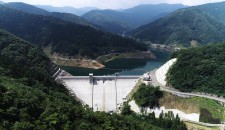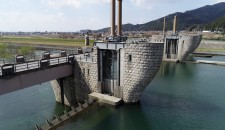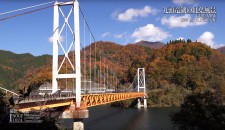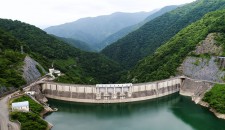Terms of dam
The glossary of this page is based on ”Dam Dictionary” by Japan Dam Association.
Structure of dam
| Concrete gravity dam | A concrete dam that supports the water pressure by the weight of the dam. It is constructed on solid foundation rocks that support the weight of the dam. |
|---|---|
| Arch dam | It is also called a concrete arch dam that have an arched shape when viewed from above. It supports the weight of the dam by transmitting water pressure to the rock ground of both banks with the arch. It is more economical than a concrete gravity dam, but it requires hard ground on both banks. |
| Gravity arch dam | It has both properties of a concrete gravity dam and an arch dam. That is rare and there are only twelve gravity arch dams in Japan. Three of them are in Fukui Prefecture. |
| Rock-fill dam | It is a dam that is constructed by pilling up rocks, earth and sand. |
Part names
| Dam body | It is the main body of a dam. |
|---|---|
| Upper surface | It is the top part of a dam body. It is mostly used as a road or a sidewalk. There are examples of running a national road. |
| Crest | It is the uppermost part of a dam body. |
| Spillway | It is a general term of discharge equipments for safety purposes of dams during times of flooding. |
| Regular spillway | As for the dams with a regular spillway and an emergency spillway, the spillway used for regular flood control is called a regular spillway. |
| Emergency spillway | It is an antonym of a regular spillway and it discharges exceed water of release by a regular spillway. |
| Energy dissipator | It is a construction to prevent damages by erosion by reducing the energy of water from a dam. There are hydraulic jump type, ski jump type and free fall type. |
Discharge equipments
| Gate | An equipment such as a spillway that discharges water from dams, which is used for opening and shutting, adjusting discharge rate. |
|---|---|
| Roller gate | A gate with roller on the slide gate, which can be moved up and down. Under intense water pressure, it can be opened and shut easily. Roller gates or radial gates are common for parts such as spillways that are under intense water pressure. |
| Radial gate | It is also called a Tainter gate. The surface is arc-like, and the gate opens and shuts by rotating around the center of the arc. |
| Howell Bunger valve | A valve to spread the flow of water by a cone that fixed on edge and is widely used for dam's discharge conduits. It opens and shuts by moving tubes outer the cone. |
Gate position and others
| Crest gate | A gate installed on the crest of the dam. Usually, it is used as an emergency gate to prevent overflow from the upper surface when there is an extreme flood. |
|---|---|
| Conduit gate | A gate installed at the bottom of the dam body. The dams with both crest gate and conduit gate are common, and each one is used as an emergency spillway and a regular spillway. |
| Orifice gate |
It is the gate installed at the middle of the dam body. Usually, a conduit gated is installed at the bottom of the dam body, and an orifice gate is installed at the middle of it. |
| Pumped-storage power generation | Usually, it is the structure with an underground power plant and two ponds (upstream and downstream). It generates electricity by running water pooled at a daytime peak period from the upstream pond to the downstream one. Pooled water in the downstream pond is pumped up at night that less power is consumed. |







